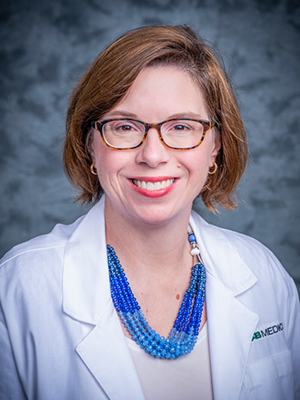Paige M. Porrett, M.D., Ph.D., associate professor in the Department of Surgery, has recently been honored with the Heersink School of Medicine's Featured Discovery award. She has been awarded alongside the first authors Rebecca Asiimwe, bioinformatician III in the Porrett Lab, and Matthew D. Cheung, a medical scientist graduate trainee. This initiative recognizes significant research contributions from Heersink faculty members. Paige M. Porrett, M.D., Ph.D.
Paige M. Porrett, M.D., Ph.D.
Their study, “Spatiotemporal immune atlas of a clinical-grade gene-edited pig-to-human kidney xenotransplant,” was published in Nature Communications .
“This work is the result of a huge collaborative effort between many different departments at UAB. It was such an incredible opportunity to be a part of the groundbreaking research that has the ability to directly affect patients suffering with kidney failure,” stated Cheung.
In this study, a humanized pig kidney was transplanted into a brain-dead individual, and the kidney graft was biopsied over the three days of the study. Previously published clinical results of this decedent study have now been supplemented with a completed immunologic analysis of kidney biopsies. This work is significant because it distinguishes human from pig immune cells in the pig kidney xenograft, providing insight into the immune response to a pig kidney xenotransplant.
“The uniqueness of this study transcends that of many studies I have conducted in the past, both clinically and computationally. With the need to factor in the study of cross-species cells, our research presents unparalleled and unique opportunities to move the field of xenotransplantation forward, as we work towards translational kidney research for improved patient care,” explained Asiimwe. “We also anticipate that our results, lessons learned, and the unique methods applied in this study will have great utility in similar studies to advance xenotransplantation beyond current limits”.
The Heersink communications team met with Porrett to learn more and spread awareness about the study and the Heersink School of Medicine.
Q: What compelled you to pursue this research?
There are not enough organs to meet demand in transplantation, and the use of organs from genetically engineered pigs may help decrease the organ shortage. That said, at the time we undertook this study, there had not been a prior opportunity to study the human immune response to a pig kidney xenotransplant.
Q: What was your most unexpected finding?
That there was limited infiltration of the pig kidney by human immune cells that are called monocytes, and the monocytes were not particularly inflamed. We expected the transplantation process to provoke inflammation in the organ, but we did not observe significant inflammation from the few human monocytes that arrived over this short study. Importantly, we don't know yet what happens over a longer timeline.
Q: How do you feel your research will impact the science community?
We are the first group to devise strategies to identify human from pig kidney cells in biopsy tissues where we are limited by cell number; such strategies will be very important in future studies where it is necessary to distinguish the two cell types. We did this in many ways, allowing us to provide flexibility to the community and demonstrate high rigor with these techniques. Notably, human and pig cells cannot be distinguished from one another based on conventional microscopy in a pathology laboratory, so techniques which allow the origin to be identified are very needed.
Q: What is your research’s relevance to human disease?
Xenotransplantation has the potential to mitigate the current organ shortage, but there are several knowledge gaps that must be filled to safely pursue this in living humans. Understanding how the human recipient of a pig kidney responds to the transplant is a key goal.
Q: When did you know you had an important discovery?
I wish I could say there was a single "Eureka" moment, but every scientist who may read this note knows full well that months (if not years) of failure are the most common outcome when pursuing innovation and discovery. I suppose we had our “Eureka” moment when our team devised and executed the multiple validation analyses which all gave us the same answer. Time will tell if it was the right one!
While our team worked extremely hard to validate our findings and we have great confidence in our result, it will only be after other teams perform similar research that we will know if our work represents the "ground truth." It's important to acknowledge our co-authors Chris Fucile, Alex Rosenberg, and Shawn Little for devising these validation strategies.
Q: How has being at UAB and living in Birmingham affected your research?
UAB has enabled my research in ways that are hard to describe. Being a surgeon-scientist is challenging because you are pulled in many directions. I am grateful to many individuals at UAB who let me pursue this work by providing me with protection from clinical responsibilities to get this done. That includes university and hospital administration, as well as the clinical transplant surgeons in our group who do the most important work. And this would never have been accomplished without the multiple members of our research team and our core facilities at UAB.
Q: What do you find makes the science community here unique?
It's extremely collaborative and resourceful. I've found that people are very open to new ideas. I hope it stays that way as Alabama needs its scientists now more than ever. I really hope that our science community can move the needle by engaging with our state leaders and the communities around us so that everyone understands how science propels the world and improves the lives of generations to come. We need each other!